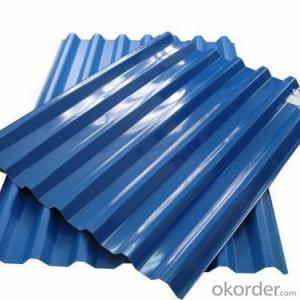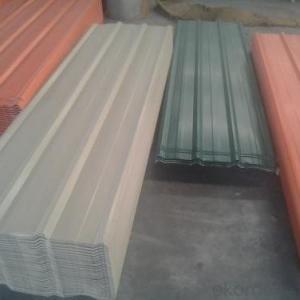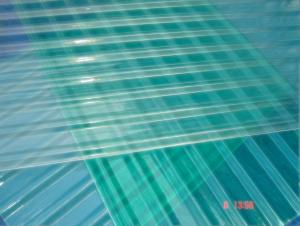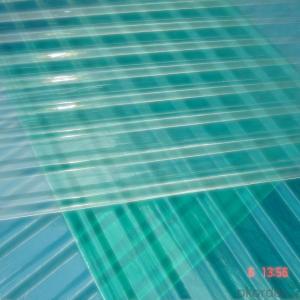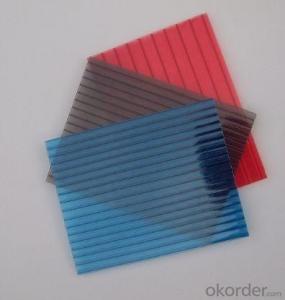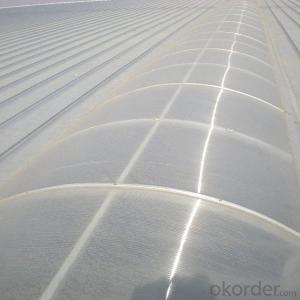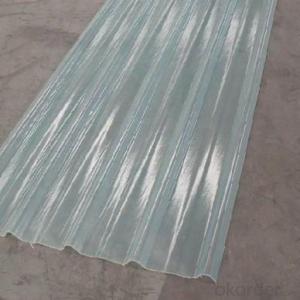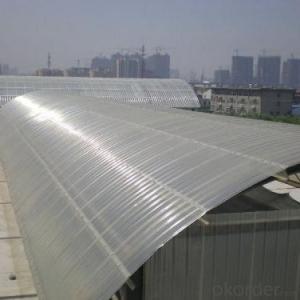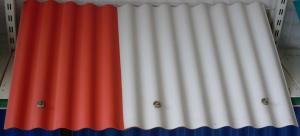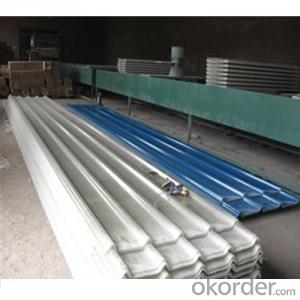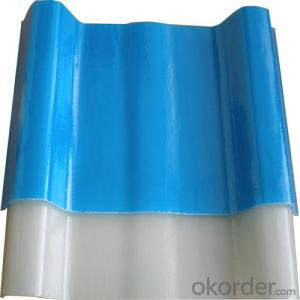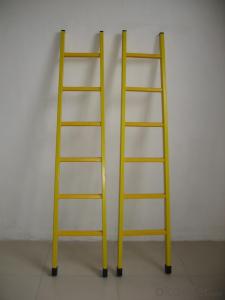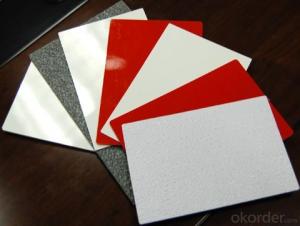Fiberglass/ Fiberglass Reinforced Plastic (FRP) Panel
- Loading Port:
- Tianjin
- Payment Terms:
- TT OR LC
- Min Order Qty:
- 500 m
- Supply Capability:
- 60000 m/month
OKorder Service Pledge
OKorder Financial Service
You Might Also Like
Item specifice
PRODUCT DESCRIPTION
Fiberglass/ Fiberglass Reinforced Plastic (FRP) or Glass Fiber Reinforced Plastic (GRP) is composed of thermosetting plastics and reinforced fiberglass, Greater than that of steel products and aluminum products in specific tenacity.
Products in the ultralow temperature or high temperature will not happen brittle fracture, deformation and to prevent heat transfer. Corrosion products in the environment anti-aging, yellowing resistance, corrosion resistance, friction resistance, easy to clean.Can be instead of aluminum, stainless steel plates, tiles and so on.
FEATURES
1). Light Transmission: The light transmission of FRP roof sheet is between 3%-85%. Light through FRP corrugated sheet scatters and is mild. It will not form a light so as to make the indoor brighter.
2). Weather resistant: The UV agent mixing in the corrugated sheet, which can truly resist the damage of ultraviolet ray, which can truly resist the damage of ultraviolet ray.
3). Flame retardant: B1 grade.
4). Anti-corrosion: It resists chemical corrosion and its life span is over 3 times longer than zinc panel.
5). Water proof:100% water proof.
6). Impact capacity: resist impact, tensile and hardly breakable.
7). Light weight: the weight is light, etc
SPECIFICATIONS
| Name: | Fibreglass Reinforced Polyester(FRP ) Sheet |
| Material: | Protective film, Unsaturated resin polyester, Fiberglass |
| Weight: | 1800g/2400g/2750g/3050g Square meter |
| Thickness: | 0.8~3.0mm |
| Length: | Customized |
| Temp: | used in -40°c to 140 °c |
| OEM: | Welcomed |
| Color: | Clear/Blue |
PICTURES
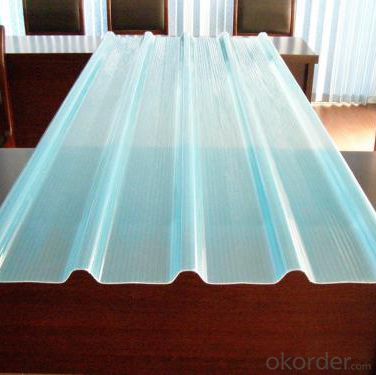

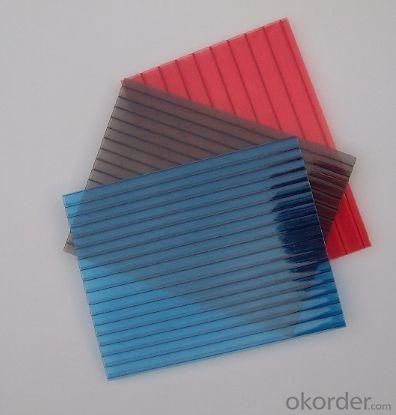
- Q:Are FRP roofing panels suitable for residential applications?
- Yes, FRP (Fiberglass Reinforced Plastic) roofing panels can be suitable for residential applications. FRP panels are lightweight, durable, and versatile, making them a popular choice for various residential roofing needs. They are highly resistant to corrosion, weathering, and UV radiation, ensuring a long lifespan with minimal maintenance. Additionally, FRP panels offer excellent insulation properties, helping to regulate the temperature and reduce energy consumption in residential buildings. They are available in a range of colors and designs, allowing homeowners to achieve their desired aesthetic while benefiting from the practical advantages of FRP roofing panels. Overall, FRP roofing panels can be a cost-effective and reliable option for residential applications.
- Q:Can FRP roofing panels be installed in high wind zones?
- FRP roofing panels can be installed in high wind zones, but it's crucial to note that the wind resistance of these panels may vary depending on the manufacturer and thickness. To ensure proper installation in high wind zones, it's recommended to follow the manufacturer's guidelines and specifications. This may involve using appropriate fasteners, sealants, and installation techniques to enhance the panel's wind resistance. It's also advisable to consult with a professional roofing contractor or engineer who has experience with FRP panels and can offer guidance on proper installation methods in high wind areas. Additionally, it's essential to consider local building codes and regulations when installing FRP roofing panels in high wind zones. These codes may have specific requirements for wind resistance and may require additional measures, such as increased fastener spacing or additional roof bracing, to ensure the panels can withstand the strong winds. Ultimately, by using proper installation techniques, following manufacturer guidelines, and complying with local building codes, FRP roofing panels can be installed and perform effectively in high wind zones.
- Q:Do FRP roofing panels require a specific type of gutter system?
- Yes, FRP roofing panels typically require a specific type of gutter system designed to accommodate the unique characteristics of these panels. The gutter system should be designed to effectively handle the water flow and potential expansion and contraction of the FRP roofing panels. Consulting with a professional or the manufacturer of the panels is recommended to determine the most suitable gutter system for FRP roofing panels.
- Q:Can FRP roofing panels be used for covered bike racks or bicycle shelters?
- Certainly, covered bike racks and bicycle shelters can make use of FRP (Fiberglass Reinforced Plastic) roofing panels without a doubt. Renowned for their durability, strength, and resistance against weather, FRP panels emerge as an excellent selection for outdoor structures like bike shelters. These panels are specifically engineered to endure harsh weather conditions such as rain, snow, and even UV rays, thereby assuring the safeguarding of bicycles against the elements. Moreover, FRP panels boast a lightweight nature and simple installation process, rendering them a cost-effective solution for establishing covered bike racks or shelters. Architects and builders frequently opt for FRP roofing panels due to their capacity to provide a robust and long-lasting haven for bicycles, thereby solidifying their status as a favored choice for constructing bike shelters and racks.
- Q:Are FRP roofing panels suitable for industrial applications?
- Yes, FRP (Fiberglass Reinforced Plastic) roofing panels are indeed suitable for industrial applications. FRP roofing panels have a number of qualities that make them well-suited for industrial settings. Firstly, FRP panels are highly durable and long-lasting. They are resistant to corrosion, weathering, and UV radiation, which are all common challenges faced in industrial environments. This durability ensures that FRP panels can withstand harsh conditions and provide reliable protection for a long period of time. Furthermore, FRP roofing panels are lightweight yet strong, making them easy to handle and install. Their lightweight nature reduces the load on the structure, which can be particularly advantageous in industrial applications where large roof areas need to be covered. Additionally, their strength allows them to support heavy equipment or machinery that may be present in industrial buildings. Another important aspect is that FRP panels are non-conductive and provide excellent insulation properties. This is particularly valuable in industrial settings where electrical equipment or high temperatures may be present. FRP panels can help to regulate heat transfer and reduce energy consumption, contributing to a more energy-efficient and cost-effective operation. Moreover, FRP roofing panels are low maintenance. They are resistant to chemicals and do not require frequent painting or coating, unlike other roofing materials commonly used in industrial settings. This results in reduced maintenance costs and efforts over the lifespan of the panels. Lastly, FRP panels are available in a variety of profiles, colors, and sizes, allowing for customization to suit specific industrial requirements. This versatility ensures that FRP panels can be adapted to various industrial applications, such as warehouses, manufacturing facilities, chemical plants, and more. In conclusion, FRP roofing panels are indeed suitable for industrial applications due to their durability, lightweight yet strong nature, non-conductive insulation properties, low maintenance requirements, and versatility in terms of customization. They provide reliable protection, reduce costs, and contribute to a safer and more efficient industrial environment.
- Q:Are FRP roofing panels resistant to gasoline spills?
- No, FRP roofing panels are not typically resistant to gasoline spills.
- Q:Are FRP roofing panels resistant to warping or sagging from prolonged exposure to heat?
- FRP roofing panels exhibit a remarkable ability to resist warping or sagging caused by prolonged heat exposure. These panels are specifically engineered to endure extreme temperatures while maintaining their structural integrity. The presence of fiberglass reinforcement within the panels grants them exceptional strength and stability, rendering them highly resistant to thermal expansion and contraction. Consequently, even when subjected to intense heat, FRP roofing panels remain unwavering, ensuring long-lasting performance and durability. Additionally, these panels possess commendable dimensional stability, further safeguarding against any deformation or distortion induced by heat exposure. Hence, FRP roofing panels prove to be a dependable choice for applications necessitating resistance against warping or sagging due to extended heat exposure.
- Q:Can FRP roofing panels be used in churches or religious buildings?
- FRP roofing panels are a suitable choice for churches or religious buildings due to their durability, lightweight nature, and exceptional weather resistance. These panels are commonly used in commercial and industrial structures but can also be utilized in religious establishments. One notable advantage of FRP panels is their ability to allow natural light into the building while providing insulation. This creates a warm and inviting atmosphere, especially in churches where natural light is desired. Additionally, these panels are available in a variety of colors and finishes, allowing customization to match the aesthetic of the religious building. Moreover, FRP panels are easy to install and maintain, making them a cost-effective option for churches or religious buildings with limited budgets. They possess resistance against corrosion, rust, and UV radiation, ensuring their durability and reducing the need for frequent repairs or replacements. However, it is crucial to consult with a professional or roofing specialist to assess the specific requirements and determine if FRP panels are the optimal choice for a particular church or religious building. Factors such as local climate, building codes, architectural design, and structural considerations must be carefully considered before reaching a final decision.
- Q:Can FRP roofing panels be cut or trimmed on-site during installation?
- Yes, FRP roofing panels can be cut or trimmed on-site during installation. These panels are typically made of fiberglass reinforced plastic and can be easily cut with tools such as a circular saw or a jigsaw. It is important to follow the manufacturer's guidelines and use appropriate safety measures when cutting or trimming FRP roofing panels.
- Q:Do FRP roofing panels require a specific type of ventilation?
- Ventilation is a must for FRP roofing panels as it ensures their durability and performance. These panels tend to expand and contract due to temperature changes, so proper ventilation is necessary to prevent warping, cracking, or failure. To achieve this, ridge ventilation is the ideal option for FRP roofing panels. This involves installing ridge vents at the roof's peak to allow hot air to escape from the attic or space beneath the roof. By enabling a continuous flow of air, ridge ventilation prevents the accumulation of heat and moisture, which can be detrimental to the FRP panels. Alongside ridge ventilation, it is essential to have adequate soffit or eave vents to allow fresh air to enter the attic or space beneath the roof. This balanced airflow helps regulate temperature and moisture levels, providing further protection for the FRP roofing panels. It is important to note that specific ventilation requirements may vary based on the manufacturer's recommendations or local building codes. Hence, referring to the manufacturer's guidelines or seeking professional advice is advisable to ensure optimal performance and longevity of the FRP panels.
1. Manufacturer Overview |
|
|---|---|
| Location | |
| Year Established | |
| Annual Output Value | |
| Main Markets | |
| Company Certifications | |
2. Manufacturer Certificates |
|
|---|---|
| a) Certification Name | |
| Range | |
| Reference | |
| Validity Period | |
3. Manufacturer Capability |
|
|---|---|
| a)Trade Capacity | |
| Nearest Port | |
| Export Percentage | |
| No.of Employees in Trade Department | |
| Language Spoken: | |
| b)Factory Information | |
| Factory Size: | |
| No. of Production Lines | |
| Contract Manufacturing | |
| Product Price Range | |
Send your message to us
Fiberglass/ Fiberglass Reinforced Plastic (FRP) Panel
- Loading Port:
- Tianjin
- Payment Terms:
- TT OR LC
- Min Order Qty:
- 500 m
- Supply Capability:
- 60000 m/month
OKorder Service Pledge
OKorder Financial Service
Similar products
New products
Hot products
Related keywords


